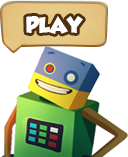The first journey RoboGarden presents is built around a virtual celebration in a birthday event hosted by Robo, RoboGarden’s hero robot, and his friends. A lot of strong morals and good practices are taught as the adventures and missions progress. Each step of the way, Robo gets to know new people and finds unique ways to help his friends. The storyline starts with Robo being asked to get along with new people, to make new friends, and to help others out.
Robo learns that being cooperative is a kindness, as well as how to behave when he is invited to somebody's place. He also learns about good habits like returning the things he uses to their original places and helping to set up a party and to clean up when it’s done.
While Robo is learning important life lessons, students will learn about controls and commands that help Robo achieve the missions and complete his journey successfully. They will learn Robo’s basic movements inside the field and about functions like setting colors and writing text that change the field’s layout and appearance. Students will solve missions that require them to play and apply simple math concepts as they grow familiar with Robo’s motor actions. As they progress deeper into the journey, students will learn about single-digit addition, reading and writing text, and changing the colors of cells.
Students gain a lot as they work through RoboGarden journeys. To a child, they have played a fun game for a couple of hours, learned a lot about commanding and programming a robot, and become more comfortable adding numbers. Meanwhile, a very important engineering concept is covered without the student ever realizing it.
We have mentioned that RoboGarden’s programs incorporate NGSS standards. In this case, the 3-5-ETS1 Engineering Design standard is covered. A simple design problem is defined, such as the location of a specific object with the goal of planning out the path that will reach it. In other cases, the problem could also reflect a need or a want that includes specified criteria for success and constraints on materials, time, or cost. One example of this approach is when Robo is asked to get some sweets for his friends and finds that he must make some decisions.
Generating and comparing multiple possible solutions to a problem to determine how well each will meet the criteria and constraints is an important skill. This type of thinking is reinforced in the missions that Robo must solve to end his journey.
There may be 40 missions per journey, but students learn more than 40 new things as they move forward with Robo. Are you ready to try it for yourself? Check out “Get to know the world in the birthday party” to start down the RoboGarden path of learning.

